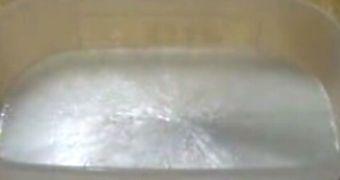Sodium acetate trihydrate crystals dissolved in hot water and cooled off stay liquid until the solidification process is triggered with one's finger. The exothermic ice thus obtained emanates heat.
I bet that when winter comes and you go ice skating, upon warming up your frozen fingers many of you think "What if ice were warm?" Well, believe it or not, it is possible, though not in the way you might have imagined. In order to see for yourselves what hot ice would look like, here comes an easy guide, so that you can prepare it yourselves.
Get in possession of some sodium acetate (heating pads or hand warmers contain such a substance). Any form will do, both the gel from the warming pad or the more common powder. The first step is to dissolve as much of it as you can (a cupful is good for starters) into almost boiling water. First place the acetate into a pan and then add just enough water until it dissolves. Be careful not to add too much water, because you want to supersaturate the solution and make it as dense as possible for the best results.
Then heat the pan and stir until the water is close to boiling. This is actually when the sodium acetate crystals dissolve, reaching liquid form. What you need to do is add acetate until the mixture can hold no more, which you'll know by noticing that crystals don't dissolve anymore, remaining instead on the bottom of the pan. If this doesn't happen, add more.
When this is done, transfer the solution into any container that can be put in the fridge. Make sure that only the liquid goes into the container and absolutely none of the undissolved crystals. Keep those in the pan, otherwise it all goes wrong. Normally, at the temperature in the fridge, which is way below the one the mixture is formed at, the solution would crystallize again. But since you supersaturated it, it "supercools" instead, reaching a temperature below the normal crystallization one without doing so. After about an hour, you can take it out of the fridge and, if you need to pour it into a better container, this is your last chance. While doing so, watch out not to spill any of it and make sure that it doesn't come into any contact with solid sodium acetate.
The final step is to place a tiny bit of solid acetate on your finger or any other object that holds it and shortly touch the mixture with it. Be careful not to stick your finger for too long if you don't want hot ice getting stuck to it. What happens now is that the solid crystal triggers the solidification process as it creates a nucleation center. Your solution should turn into an ice-looking one, and if you touch it, you'll notice it's warm (54°C, 130°F), because crystal formation releases energy.
Caution: don't eat the ice and, if you're not sure what to do, ask for supervision.

 14 DAY TRIAL //
14 DAY TRIAL //